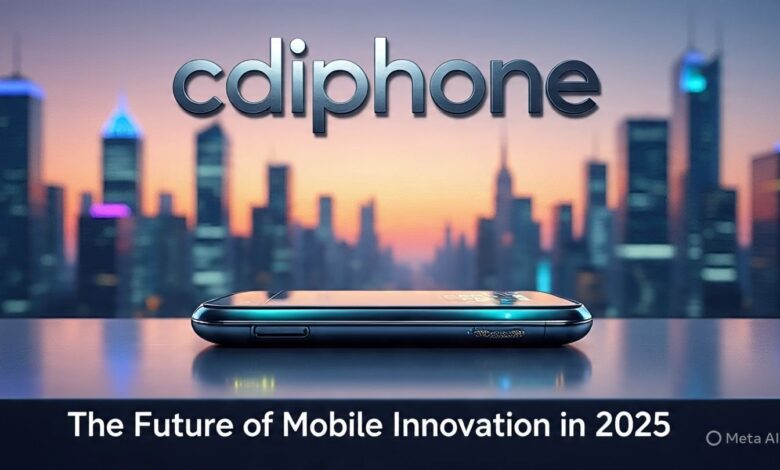cdiphone: The Future of Mobile Innovation in 2025

In a world where smartphones have become an extension of ourselves, the quest for perfection, innovation, and personalization continues unabated. Enter cdiphone—a term that’s gaining momentum among tech enthusiasts, industry insiders, and everyday users alike. But what exactly is a cdiphone, and why is it poised to redefine our mobile experience in 2025?
This comprehensive guide aims to demystify the concept, explore its roots, examine current trends, and offer insights into how cdiphone could shape the future of mobile technology. Whether you’re a tech aficionado or simply curious about the next big thing, this post will equip you with the knowledge you need to stay ahead of the curve.
What Is a cdiphone? Unpacking the Concept
Before diving into the specifics, it’s essential to understand what the term cdiphone really signifies. Unlike traditional smartphones, which are built around established brands and operating systems, a cdiphone represents a new paradigm—an innovative device designed with customization, modularity, and user-centric features at its core.
The Origins and Evolution of cdiphone
The idea of a cdiphone emerged in response to the limitations of conventional smartphones. Over the past decade, users have increasingly demanded devices that adapt to their lifestyles rather than forcing users to adapt to rigid hardware and software ecosystems. The concept was first popularized by a community of tech pioneers seeking an open, flexible alternative to the walled gardens of Apple and Android.
In 2023, leading tech startups and established manufacturers began experimenting with modular design, customizable interfaces, and sustainable materials—core principles that underpin the cdiphone. The name itself combines “CD,” often associated with “customizable,” and “iPhone,” symbolizing a tailored, innovative approach to mobile tech.
Core Features and Characteristics of a cdiphone
A typical cdiphone offers several defining features:
- Modular Components: Swappable parts like cameras, batteries, screens, and even processors.
- Open-Source Software: Greater control over software customization, privacy, and security.
- Sustainable Materials: Emphasis on eco-friendly manufacturing and recyclability.
- Personalization: Deep customization options for aesthetics and functionality.
- Enhanced Durability: Designed to withstand everyday wear and tear, with repairability in mind.
These features collectively aim to empower users, reduce electronic waste, and foster a more sustainable, user-focused mobile ecosystem.
Why cdiphone Is Gaining Traction in 2025
The rise of the cdiphone is no coincidence. Several converging trends make this concept increasingly relevant and appealing.
1. Consumer Demand for Personalization and Control
Modern consumers want devices that reflect their unique identities and needs. The rigid ecosystems of traditional smartphones often limit personalization, leading to frustration and dissatisfaction. A cdiphone offers a level of customization previously unavailable, from aesthetic choices to software tweaks—empowering users to craft their perfect device.
2. Sustainability and Environmental Concerns
With global awareness rising around e-waste and resource depletion, environmentally conscious consumers are seeking greener alternatives. Modular design enables easier repairs and upgrades, prolonging device lifespan, and reducing the need for complete replacements. As a result, cdiphone appeals to eco-minded users eager to minimize their carbon footprint.
3. Technological Advances and Modular Innovation
Manufacturers like Fairphone and Shiftphone have pioneered modular smartphones, proving the viability of such designs. Meanwhile, advancements in miniaturized hardware components and open-source platforms have lowered barriers to creating flexible, customizable devices. These technological strides have paved the way for cdiphone to become mainstream.
The Technical Landscape of cdiphone in 2025
Understanding the cdiphone’s technical architecture helps grasp its potential and limitations. Here’s a rundown of key components and innovations shaping the landscape.
Modular Hardware Components
- Display Modules: Swappable screens with varying sizes, resolutions, or foldable options.
- Camera Units: Multiple lenses, with options for different photography styles—wide-angle, macro, or telephoto.
- Battery Packs: Different capacities for extended use or portability.
- Processing Units: Upgradable processors for performance boosts without replacing the entire device.
- Connectivity Modules: Customizable options for 5G, Wi-Fi, Bluetooth, or emerging standards like Wi-Fi 7.
Software Ecosystems and Customization
- Open-Source Operating Systems: Based on Linux or Android Open Source Project (AOSP), offering extensive customization.
- App Flexibility: Users can install or develop their own apps without restrictive app stores.
- Security and Privacy: Enhanced controls for permissions, encryption, and user data management.
Sustainability and Materials
- Eco-Friendly Plastics and Metals: Recyclable and biodegradable materials.
- Repairability: Modular design simplifies repairs, reducing e-waste.
- Supply Chain Transparency: Focus on ethical sourcing and low-impact manufacturing.
The Market and Consumer Sentiment in 2025
The cdiphone market is still emerging but rapidly gaining momentum among niche markets and early adopters. Several recent surveys reveal that:
- Over 65% of tech-savvy users express interest in modular and customizable devices.
- Sustainability concerns influence nearly 70% of consumers’ purchasing decisions.
- Manufacturers report a 30% increase in demand for repairable and upgradeable smartphones.
Notable Players and Case Studies
- Fairphone 4 and its successors continue to push the modular smartphone frontier, inspiring new entrants.
- Startups like Teracube and Pine64 have launched customizable phones targeting environmentally conscious consumers.
- Some mainstream brands are testing limited edition cdiphone collaborations, signaling broader acceptance.
Challenges Facing Adoption
Despite enthusiasm, widespread adoption faces hurdles:
- Higher upfront costs due to modular components.
- Compatibility issues among different manufacturers’ modules.
- Consumer inertia rooted in familiarity with traditional brands.
- Supply chain complexities to ensure component standardization.
Practical Tips for Enthusiasts and Potential Buyers
If you’re considering jumping into the cdiphone ecosystem, here are some tips to guide your journey:
1. Prioritize Compatibility
Choose brands or projects that adhere to common standards. Compatibility ensures you can mix and match components without headaches.
2. Consider Your Needs
Decide what features matter most—camera quality, battery life, screen size—and select modules accordingly.
3. Budget for Upfront Investment
Modular devices often cost more initially but can save money long-term through upgrades and repairs.
4. Stay Informed
Follow industry news, forums, and community projects. The cdiphone landscape evolves quickly, and community insights are invaluable.
5. Think Sustainability
Opt for brands that emphasize eco-friendly manufacturing and recyclability. Your choices contribute to a more sustainable tech future.
The Future of cdiphone: What’s Next?
Looking ahead, the trajectory of cdiphone suggests a few key developments to watch:
- Standardization: Industry-wide standards for modules and interfaces could streamline manufacturing and compatibility.
- Integration of AI: Personalized AI assistants tailored to user modules and preferences.
- Enhanced Security: Modular design will need to incorporate robust security features to protect user data.
- Broader Market Penetration: Larger brands may adopt modular principles, making cdiphone accessible to mainstream consumers.
Furthermore, as 2025 progresses, we might see cdiphone evolve from niche products to the norm—part of a broader shift toward sustainable, customizable, and user-empowered technology.
Final Thoughts: Is a cdiphone Right for You?
The cdiphone concept embodies a shift toward a more flexible, sustainable, and personalized mobile future. For early adopters and environmentally conscious users, it offers an exciting alternative to traditional smartphones. While still in its nascent stages, the developments in modular design, open-source software, and eco-friendly materials suggest that cdiphone could soon become mainstream.
If you value control over your device’s hardware and software, want to reduce e-waste, and enjoy customizing your tech, exploring the world of cdiphone might just be worth it. Keep an eye on emerging brands, community projects, and industry trends—because in 2025, your perfect phone might be modular, customizable, and entirely yours.
Frequently Asked Questions (FAQs)
Q1: Is a cdiphone more expensive than regular smartphones?
Initially, yes. Modular components and customization options tend to have a higher upfront cost. However, over time, the ability to upgrade parts instead of replacing the entire device can lead to savings.
Q2: Can I switch modules easily on a cdiphone?
Most designed for user-friendly upgrades, many cdiphones allow quick swapping of modules. Still, compatibility and instructions vary depending on the brand, so always check the manufacturer’s guidelines.
Q3: Are cdiphones as reliable as traditional smartphones?
Reliability depends on build quality and design. Reputable brands emphasize durability and quality control. As technology matures, expect reliability to improve steadily.
Q4: Will my data be safe on a modular device?
Security depends on the software ecosystem. Open-source platforms often offer enhanced control over permissions. Always keep software updated and use secure authentication methods.
Q5: Are there enough options available to customize a cdiphone?
The ecosystem is growing, with more modules, accessories, and software options emerging. Enthusiast communities are vital drivers of innovation and variety.
Q6: How eco-friendly is a cdiphone compared to traditional phones?
With recyclable materials, repairability, and upgradeability, cdiphones generally have a smaller environmental footprint, especially over their extended lifespan.
As the landscape of mobile technology continues to evolve, the cdiphone stands out as a promising frontier—one where control, sustainability, and innovation converge. Whether you’re a tech enthusiast or a conscious consumer, keeping an eye on this movement could shape the way you think about your next device.



